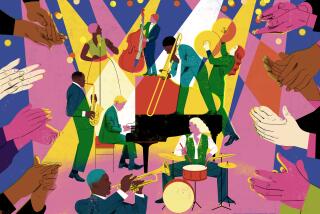Steve Coleman: Dispensing With Categories : Jazz: Saxophonist and the Five Elements to bring funk-flavored music to Catalina Bar & Grill.
- Share via
Don’t expect Steve Coleman to willingly accept the jazz label for his music.
The New York-based saxophonist is thoroughly grounded in the jazz tradition but Coleman places his music within a broad, non-Western aesthetic that dispenses with virtually all categories.
“I’m one of those musicians who is on that particular path that started back with King Oliver and Louis Armstrong,” explained Coleman, 36, by telephone from Mainz, Germany. “Bird’s (Charlie Parker’s) music was sophisticated music--it wasn’t the kind of music you could come to with no knowledge at all about the science side and really express it.
“It wasn’t like Muddy Waters’, which is just as important. I look at Bird’s music, ultimately, and Muddy Waters’ music as the same music but it’s coming from two expressions of that aesthetic.
“That’s the real connection between my music and somebody like Ice Cube’s. It’s not that I’m influenced by rap but basically I view what I do and what Public Enemy does as the same music.”
Coleman, whose Five Elements band opens at Catalina Bar & Grill on Tuesday, was a major catalyst behind the early ‘80s emergence of M-Base, a loose collective of largely Brooklyn-based musicians who have been exploring approaches beyond the usual be-bop ‘n’ standards menu. Among the highly regarded young artists associated with the group: saxophonist Greg Osby, pianist Geri Allen, vocalist Cassandra Wilson and “Tonight Show” guitarist Kevin Eubanks.
Coleman’s Catalina engagement with Five Elements, which also includes Andy Milne (keyboards), David Gilmore (guitar), Reggie Washington (bass guitar) and Gene Lake (drums), marks the first time a prominent M-Base unit has appeared here. The group’s use of electric guitar and bass and its choppy rhythms and funk flavorings may jar traditionalists bred on the smooth flow of mainstream acoustic jazz.
“All instruments are tools to me,” Coleman said. “I play the same saxophone as I played in Thad Jones’ group and Cecil Taylor’s big band and I relate to the music the same way. I don’t look at it like electronic music.”
Four recent releases display Coleman’s range. “Drop Kick,” Five Elements’ sixth album and third for Novus/RCA, and “Anatomy of a Groove” by the M-Base Collective (DIW/Sony) fall squarely in the experimental camp.
Yet “Transmigration” by Strata Institute (DIW/Sony) features Von Freeman and an acoustic rhythm section playing in a more traditional vein. So does “Rhythm in Mind” (Novus/RCA), a blend of musicians from the Dave Holland-led group in which Coleman played for 10 years.
Born in Chicago, Coleman planned on being an artist before gravitating to music and complementing his studies by playing in high school soul and funk bands. Jazz was in the house--his father favored local saxophonists Gene Ammons and Von Freeman, his mother Dinah Washington and Billie Holiday--but Coleman was more attuned to the James Brown, Funkadelic and Sly Stone records his older siblings played.
That changed after his father slipped a Bird album in among his R&B; records when Coleman went off to college, and Parker’s records led him to other early jazz icons. After absorbing practical lessons in Chicago jam sessions held by Freeman, Coleman moved to New York in 1978 and landed a spot in the Thad Jones-Mel Lewis band.
Three years later, Coleman began putting his ideas into action. “It’s the aesthetic that you use to make the music, and then what’s created and what it’s expressing. That’s the key--not what instrument somebody’s using or how much improvisation is involved,” Coleman said. “The main idea is to play creative music from our experience and to try to develop a common creative musical language among us,” he said. “I had that idea since I heard Charlie Parker. That’s what they did. That’s what I want to do, but from today’s perspective.”
More to Read
The biggest entertainment stories
Get our big stories about Hollywood, film, television, music, arts, culture and more right in your inbox as soon as they publish.
You may occasionally receive promotional content from the Los Angeles Times.










